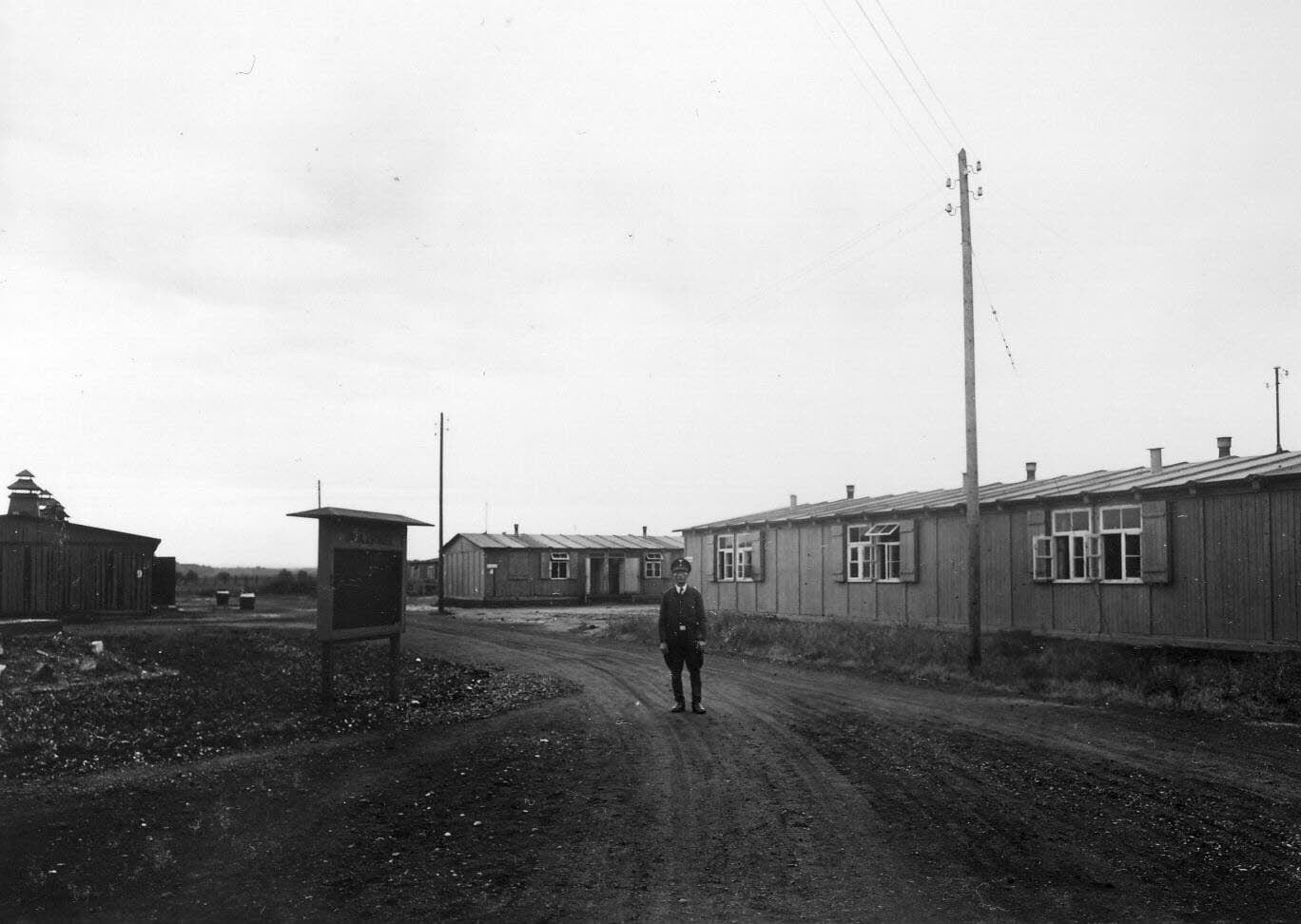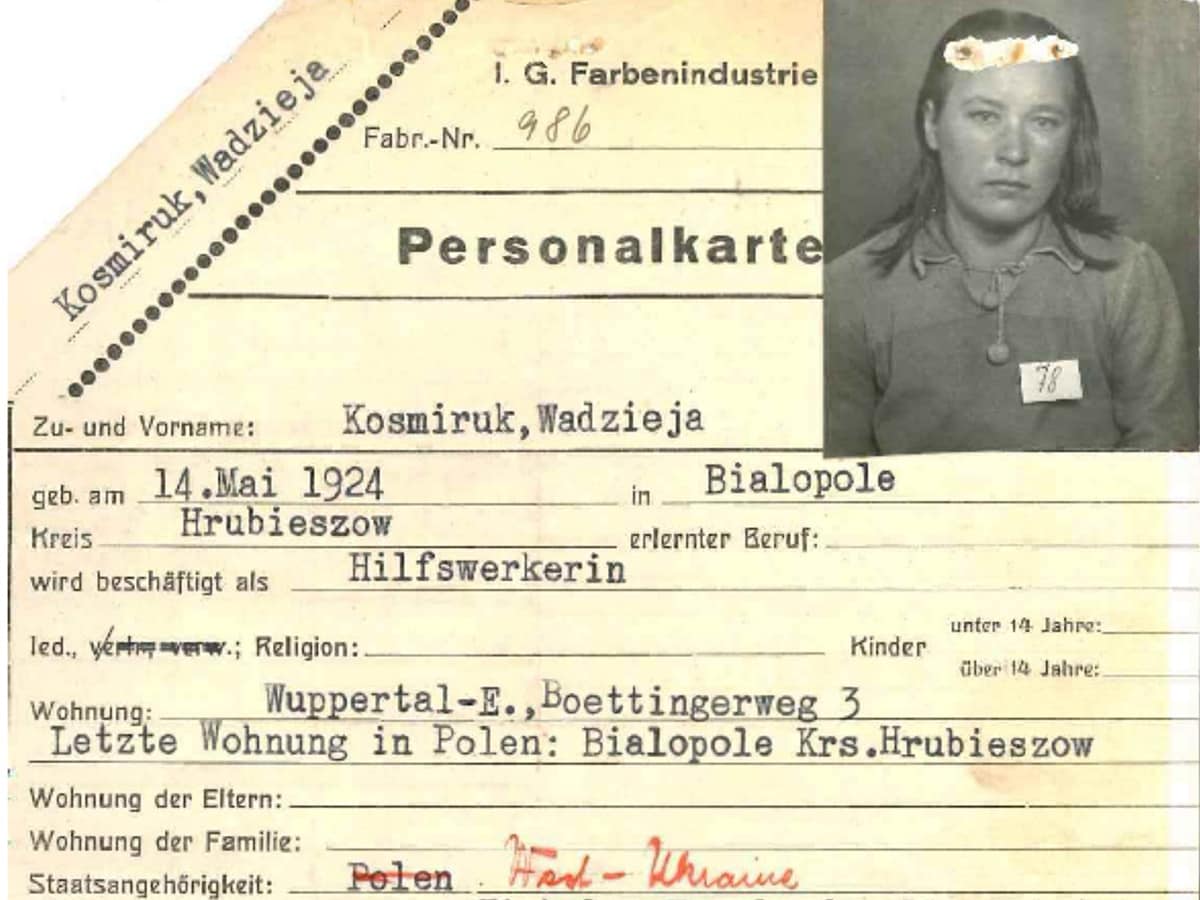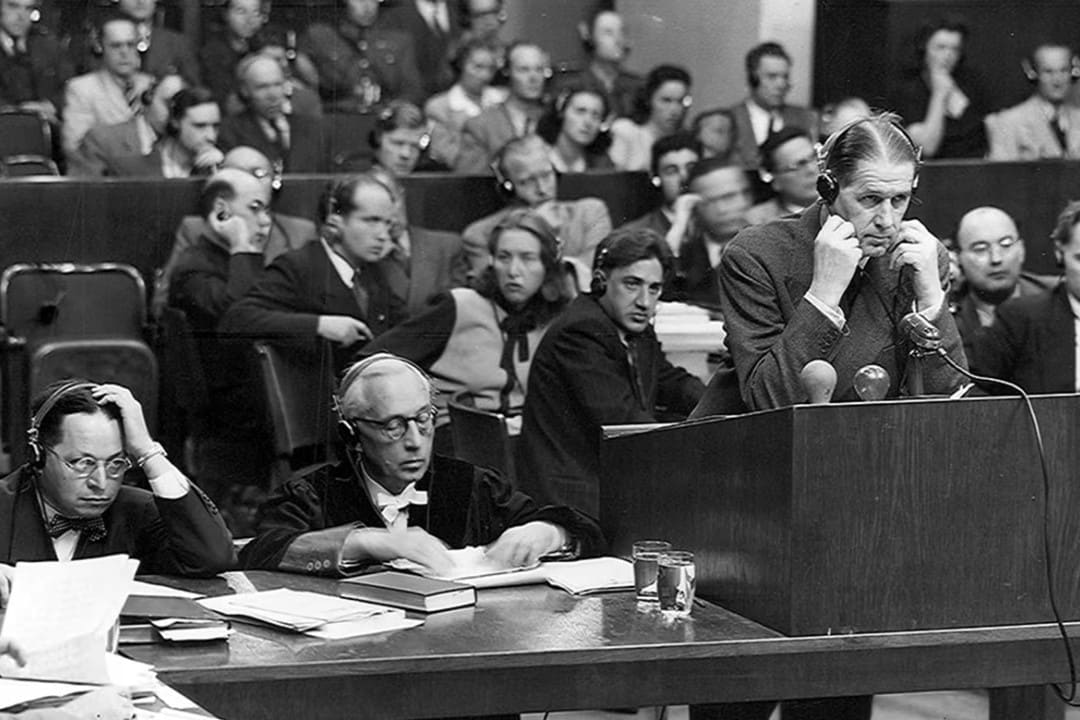Historical Background
I.G. Farben and forced labor
Forced labor – a staple of the war economy
Hierarchy among forced laborers – origin determined the level of inhumanity
How forced laborers got to the Lower Rhine sites
Daily routine for forced laborers at the Lower Rhine sites
The National Socialist government had been systematically preparing for war since 1936. When the Second World War broke out in 1939, I.G. Farben's Lower Rhine sites were deemed vital to the war effort and the German economy. As a consequence, the company decided to exploit forced laborers and established a privately financed labor camp at Auschwitz-Monowitz. The Hans and Berthold Finkelstein Foundation intends to support further independent research on this chapter into history.
After the end of the war, the conglomerate was divided into its four large constituent companies: Bayer, BASF, Hoechst and Cassella. The collaboration and involvement in National Socialist crimes were initially dealt with through the Nuremberg trials, the Wollheim suit and the Frankfurt Auschwitz trials in the 1940s, 1950s and 1960s. It was only when Bayer became a founding member of the “Remembrance, Responsibility and Future” foundation that Bayer acknowledged its historical responsibility and donated to the fund for forced laborers.
The photographers of the following images remain unidentified, but they were commissioned by I.G. Farben and portray a carefully staged scene rather than an authentic depiction of everyday reality.

View of the barracks in the Buschweg forced labor camp in Cologne-Flittard, Germany. Presumably staged by I.G. Farben for propaganda purposes. © Bayer AG, Bayer Archive Leverkusen
Forced Labor
A staple of the war economy
Forced labor was a key aspect of the Nazi regime's efforts to maintain power and control in Germany and occupied Europe during the Second World War. The regime used forced labor for systematic oppression, as a tool to punish people and exploit them for the benefit of the regime, and for the reinforcement of Nazi ideology.
Initially, forced labor had little economic relevance and was primarily intended to humiliate and degrade the victims of the Nazis. With the increasing demand for labor in different industries (armaments, and other war-relevant industries) and labor shortages beginning in late 1939 due to preparations for war, however, the deployment of forced labor became a staple of the Nazi war economy. By 1942, it was a significant economic factor. In September 1944, 20 percent of the workforce in Germany were forced laborers.
Hierarchy among Forced Laborers
Origin determined the level of inhumanity
During the Second World War, forced laborers at I.G. Farben originated from different occupied countries. Nazi ideology dictated a racist hierarchy in terms of their treatment. This was aggravated by different prejudices within the German population, which led to additional insults, denunciations, and mistreatments of forced laborers depending on their origin. Worst was the fate of concentration camp prisoners, who were condemned to "extermination through labor".
All foreign laborers were continuously monitored by the Wehrmacht, labor office, factory security, police, and SS through an elaborate system of racist bureaucratic repression. They were crammed into barracks or overcrowded restaurants and banquet halls. In the camp and factory canteens, they received very inadequate food and were not given food stamps. In the rare event that they were paid a meager wage, they could not buy food and suffered constant hunger. Between the long shifts (often longer than 12 hours) and the additional work - some individuals were given (women had to clean offices after hours), forced laborers tried to use the limited time remaining to ensure their survival - by trying to buy bread on the black market or offering services in exchange for food.

Bed room in the Leverkusen forced labor camp. Presumably staged by I.G. Farben for propaganda purposes. © Bayer AG, Bayer Archive Leverkusen

"Canteen" in the barracks of the Buschweg forced labor camp in Cologne-Flittard, Germany. Presumably staged by I.G. Farben for propaganda purposes. © Bayer AG, Bayer Archive Leverkusen

Kitchen in the Leverkusen forced labor camp. Presumably staged by I.G. Farben for propaganda purposes. © Bayer AG, Bayer Archive Leverkusen
Forced Labor at I.G. Farben
Profit from expropriation and exploitation
Together with BASF, Hoechst, Agfa, Chemische Fabrik Griesheim-Elektron, and Chemische Fabrik vorm. Weiler ter Meer, Farbenfabriken vorm. Friedr. Bayer & Co. was a founding member of I.G. Farben in 1925. During the Second World War, this German conglomerate of chemical and pharmaceutical companies profited from expropriation, exploitation and forced labor. As an important producer and supplier of synthetic materials, I.G. Farben was ivital to the Nazi war economy.
When the war resulted in thousands of German workers being drafted to the military, other I.G. Farben workers (voluntarily) changed profession and worked for the armaments industry. Bit by bit, I.G. Farben was confronted with a decreasing domestic labor supply. The possibility of being provided with cheap labor came in handy – from 1940 onward, I.G. Farben made increasing use of forced laborers from the occupied countries of Europe to maintain and expand production within the Lower Rhine sites.
At times, these laborers accounted for up to a third of the workforce – around 16,000 people were deployed at the Lower Rhine sites during the war. They predominantly originated from Poland, Ukraine and other Eastern European countries and were aged from 14 to under 50. Workers from Western and Northern European countries such as France, Belgium, the Netherlands, Spain and Denmark also made up a large proportion of the workforce. Over the course of the war, there was no I.G. Farben operation in Leverkusen that did not benefit from forced labor at some point in time.
How Forced Laborers Got to the Lower Rhine Sites – the Example of Leverkusen
Nazi laws dictated strict separation
In most cases, forced laborers were first transported to Western Germany. After transport, which sometimes took days, they arrived in Cologne. Here, representatives from the I.G. plant were allowed to pick the forced laborers they wanted. They were then taken to Leverkusen.
After arrival, a procedure followed that sometimes took several days. First, forced laborers were disinfected, a procedure many remember as being terrifying, followed by a medical examination, which was especially feared by females because of the potential sexual assaults by the soldiers present. Next came registration, with fingerprints and photos taken by the police, followed by behavioral instructions. In a final step, forced laborers had to sign an agreement falsely confirming they had come to Leverkusen of their own free will.
Nazi laws dictated a strict separation of the German and foreign workforces. This was obeyed more strictly when it came to accommodation and clothing. Forced laborers from Western countries were allowed to rent private accommodation. Eastern European forced laborers, however, were only allowed to live in shared accommodation and under constant supervision. Food supply was also handled collectively, with “superior” workers being given food stamps. In the final years of the war, all I.G. Farben plants were surrounded by camps that were subdivided into different camps for different workers. By February 1943, about half of the workforce was accommodated in these camps.

View of the barracks in the Buschweg forced labor camp in Cologne-Flittard, Germany. Presumably staged by I.G. Farben for propaganda purposes. © Bayer AG, Bayer Archive Leverkusen

Forced laborers working in the garden at the Leverkusen forced labor camp. In the background: the administration barracks, 1943. Presumably staged by I.G. Farben for propaganda purposes. © Bayer AG, Bayer Archive Leverkusen

Personell card of a woman deployed at I.G. Farben's Elberfeld site. © Bayer AG, Bayer Archive Leverkusen
A Day in the Life of Forced Laborers at the Lower Rhine Sites
Based on the German study "Forced labor in Leverkusen. Polish youths at I.G. Farben" by Valentina Maria Stefanski
Forced laborers were woken up very early in the morning - between 4 and 6 a.m., depending on the season. They were then given time to get ready, during which they had to make their bed, and have breakfast, and were sometimes allowed to shower. After this, the workers were escorted from their accommodation to the plant. Here, they were only allowed to use one dedicated entrance to minimize potential contact with the German workforce. After identification through their badge (“Fabrik-Ausweis”), they began their work.
During work, forced laborers faced constant supervision and pressure. The majority of them neither spoke nor understood German, and were led to their workplaces without briefings or instructions and had to do as they were told – even if they did not understand or know what they were supposed to do. Language barriers on both sides resulted in harsh and almost violent social interactions.
In the event of any violation of work discipline, such as idling, self-harm, poor work performance and contact breaches, forced laborers were punished. Sometimes, the entire group was punished for the violation of a single worker [p. 246]. Punishment meant payment of fines [p. 233], physical harm, being sent to punishment camp, extra work, or deprivation of food.
Lunchtime was short and was not supposed to interrupt production [p. 180]. Rules dictated the separation of German and non-German workers. Some forced laborers had lunch in the canteen, others ate it at the workplace, while others only found time to eat after their shifts had ended. There are conflicting accounts of the nature of the food provided. What is certain is that food supply worsened over time and varied depending on the nature of the labor. At times, deprivation of food was a method to put forced laborers under pressure and motivate them to work harder [p. 187].
Random inspections also took place during the day.There were regular checks to ensure forced laborers kept their lockers in order and were hiding food or food stamps or anything else they could have taken from the factory [p. 237] – anything that was found was then confiscated. Sometimes workers received mail or packages from their families. These were also checked and, if they arrived at all, it was usually after a delay, meaning any food they contained was often already spoiled [p. 245].
After work, prohibition dominated the life of forced laborers. Especially at night, a curfew forbade forced laborers from leaving their accommodation premises, leaving the forced laborers with very limited options. Some took on extra work in exchange for food. Others simply went back to the barracks. Now and then, camp management organized activities during leisure time as a chance to improve resting which in turn would increase the efficiency of forced laborers. Foreign workers founded music and singing groups, and sometimes movies were screened. Camp management used these opportunities for propaganda purposes.
I.G. Farben and the KZ Buna-Monowitz
The company’s own concentration camp
Starting in 1941, I.G. Farben built a chemical factory in the immediate vicinity of the Auschwitz concentration camp to produce Buna, a synthetic rubber that was an important part of the war economy. In addition to German workers, the company also used thousands of prisoners from the Auschwitz concentration camp to build the factory. They were joined by prisoners of war and forced laborers from all over Europe. To accommodate the workers, I.G. Farben started building the company’s own Buna-Monowitz concentration camp in 1942, in collaboration with the SS. Many died due to the inhumane living and working conditions, or were put to death in the nearby Auschwitz-Birkenau gas chambers as soon as they were no longer able to work. The life expectancy of inmates was less than four months, and over 25,000 people lost their lives on the construction site alone.

Overview of the construction site of the Buna synthesis plant at the I.G. Auschwitz-Monowitz plant, around 1943/44. © Frankfurt am Main, Fritz Bauer Institute

Fritz ter Meer at the Nuremberg Trials in 1947. Photo: Office Chief of Counsel for War Crimes, Nuremberg, Germany.
Culture of Remembrance
Following Germany's surrender in May 1945, the Allies seized I.G. Farben and initiated legal proceedings against its management as part of the Nuremberg Trials. The accused managers developed a defense narrative that shaped Bayer's approach to its I.G. Farben and Nazi past for decades. In 1947, Fritz ter Meer wrote the Kransberg Memorandum. Despite their convictions in the I.G. Farben trial of 1947/48, the defendants did not accept responsibility and were released from prison early. Almost all of them, including ter Meer, returned to senior positions. Ter Meer was chairman of the supervisory board of the newly founded Bayer AG from 1956 to 1964. His narrative on the historical connections with I.G. Farben influenced Bayer AG's corporate communications for decades.
Norbert Wollheim's lawsuit was directed against I.G. Farben in liquidation—the official legal successor—and not against Farbenfabriken Bayer AG, which was founded in 1951. Thus, the prevailing narrative of the defense and the Kransberg Memorandum had the effect that, legally speaking, the Nazi past was not carried over into the newly founded company. This narrative continued such that a commemorative publication marking the company's anniversary in 1988 addressed forced labor and the war economy but maintained the company's role as a victim. A change did not become apparent until the 2000s: in 2000, Bayer became a founding member of the Compensation Initiative for Forced Laborers. However, I.G. Farben's individual guilt remained concealed behind the collective guilt of the German economy. From that point on, Bayer began addressing the issue internally in its archives and researching the file on Dr. Hans Finkelstein. A critical examination of Fritz ter Meer did not begin until 2006. The foundation named after him continued to exist until 2007. Bayer's practice of laying wreaths on his grave every year was also only questioned and stopped at a late stage.
Since 2022, a clear step towards a fundamentally new culture of remembrance has become evident. Through its History Project, Bayer AG has openly and thoroughly addressed its Nazi past. This included updating the company website, establishing a memorial site for 16,000 forced labourers and forced labour at the former I.G. Farben sites, and the Fritz Bauer Institute's exhibition on I.G. Farben and Buna-Monowitz throughout Germany. The Hans and Berthold Finkelstein Foundation's establishment demonstrates the company's commitment to historical responsibility and its ongoing engagement with the subject.
Thore Grimm and Fabian Engel (Bayer Archive) have written a detailed article on the transformation of remembrance culture: Archiv und Wirtschaft Ausgabe 2023, Heft 4 – Themenheft "Unternehmen im Nationalsozialismus" – 1 (wirtschaftsarchive.de)

